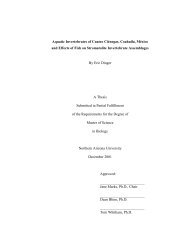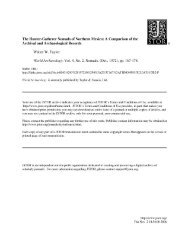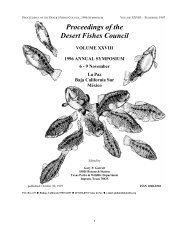Proceedings of the Desert Fishes Council 2000
Proceedings of the Desert Fishes Council 2000
Proceedings of the Desert Fishes Council 2000
Create successful ePaper yourself
Turn your PDF publications into a flip-book with our unique Google optimized e-Paper software.
PROCEEDINGS OF THE DESERT FISHES COUNCIL - VOLUME XXX1I (<strong>2000</strong> SYMPOSIUM) – PUBLISHED NOVEMBER 13, 2001<br />
more attracted to <strong>the</strong> traps that lacked bait (p < 0.01). Perhaps <strong>the</strong>se small minnows have a bigger brain and a<br />
smaller nose than we thought.<br />
RESUMEN<br />
Carnada y cambio: atracción de carpas tui a trampas cebadas<br />
Llevamos a cabo un experimento en el canal McNally, una vía de distribución del Río Owens, tres millas<br />
[4.8 km] al norte del Museo Laws, Condado de Inyo, California. El proyecto era parte de una clase de Biología<br />
Avanzada de escuela preparatoria. El objetivo era hallar una forma más efectiva de atrapar carpas tui híbridas<br />
para conocer más acerca de la nativa carpa tui del Owens, Gila bicolor snyderi. Otros métodos de captura, como<br />
la electropesca, han sido objeto de debate por la posibilidad de causar heridas a los peces. Intentamos atraer a los<br />
peces con todo, desde chocolate hasta alimento para gatos. Pensábamos que se sentirían atraídos por los aromas<br />
de nuestras preparaciones, y sin embargo encontramos que fueron más eficientes las trampas sin carnada (p <<br />
0.01). Tal vez estos pequeños peces tienen un cerebro más grande y una nariz más pequeña de lo que<br />
pensábamos.<br />
Modde, T 1 ; Kitcheyan, DC 1 ; Bowen, Z 2<br />
(1-U.S. Fish & Wildlife Service; 2-U.S. Geological Survey)<br />
Temporal and spatial use <strong>of</strong> a spawning site in <strong>the</strong> middle Green River by razorback<br />
sucker<br />
ABSTRACT<br />
Sedimentation on spawning sites in <strong>the</strong> middle Green River has been mentioned as a potential impediment<br />
to <strong>the</strong> reproductive success <strong>of</strong> razorback sucker, Xyrauchen texanus. Recent studies indicate that fine sediment<br />
moves across <strong>the</strong> Escalante spawning bar in <strong>the</strong> middle Green River. Description <strong>of</strong> <strong>the</strong> timing and distribution<br />
<strong>of</strong> fish on <strong>the</strong> spawning bar are instrumental in determining whe<strong>the</strong>r sedimentation patterns impact hatching<br />
success. In an effort to address <strong>the</strong> relationship <strong>of</strong> spawning activity to sedimentation patterns, we monitored <strong>the</strong><br />
timing and distribution <strong>of</strong> razorbackes suckers on <strong>the</strong> Escalante spawning bar during <strong>the</strong> spring <strong>2000</strong> spawning<br />
season. Razorback suckers were captured with electr<strong>of</strong>ishing boats on <strong>the</strong> Escalante spawning area (i.e.<br />
Razorback bar) in <strong>the</strong> middle Green River from 1 May through 17 May <strong>2000</strong>. Radio transmitters were externally<br />
attached to <strong>the</strong> dorsal keel <strong>of</strong> nine fish captured on <strong>the</strong> spawning bar. Two fish were <strong>of</strong> wild origin and seven<br />
were reared at <strong>the</strong> Ouray National Fish Hatchery and stocked in previous years. Eight <strong>of</strong> <strong>the</strong> nine fish were<br />
males and one was a female (hatchery origin). During a two-week period, specific locations <strong>of</strong> razorback suckers<br />
were monitored during four individual 24-hr periods. During each monitoring period, specific locations <strong>of</strong> fish<br />
were triangulated every hour. In addition, a telemetry logging station continually monitored fish presence on <strong>the</strong><br />
spawning bar. Six fish were located on <strong>the</strong> spawning bar and five fish were detected on <strong>the</strong> bar for at least five<br />
days. Fish presence on <strong>the</strong> bar was related to both temperature and discharge. The distribution and time fish<br />
spent on <strong>the</strong> bar was compared between diurnal and nocturnal hours. Fish presence on <strong>the</strong> spawning bar<br />
occurred in a very localized area with o<strong>the</strong>r apparent useable spawning areas not utilized. The duration <strong>of</strong> time<br />
fish were found on <strong>the</strong> spawning bar was underestimated using electr<strong>of</strong>ishing data only.<br />
RESUMEN<br />
Utilización temporal y espacial por el matalote jorobado de un sitio de desove en la parte<br />
media del Río Green<br />
Se ha mencionado que la sedimentación sobre los sitios de desove en la parte media del Río Green es un<br />
problema potencial para el éxito reproductivo del matalote jorobado, Xyrauchen texanus. En estudios recientes<br />
se encontró que los sedimentos finos son transportados a través de la barra de desove Escalante, en dicha parte<br />
del Río Green. Para determinar si los patrones de sedimentación influyen en el éxito reproductivo, es<br />
imperativo describir la distribución espacio-temporal de los matalotes en dicha barra. Con el objeto de<br />
averiguar la posible relación entre la actividad de desove y los patrones de sedimentación, durante la temporada<br />
11



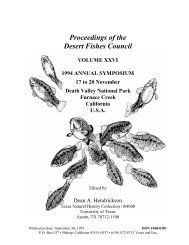
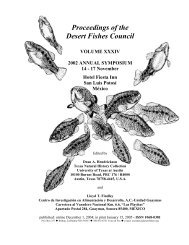
![Part 2 [419KK] - Desert Fishes Council](https://img.yumpu.com/14712282/1/190x245/part-2-419kk-desert-fishes-council.jpg?quality=85)

